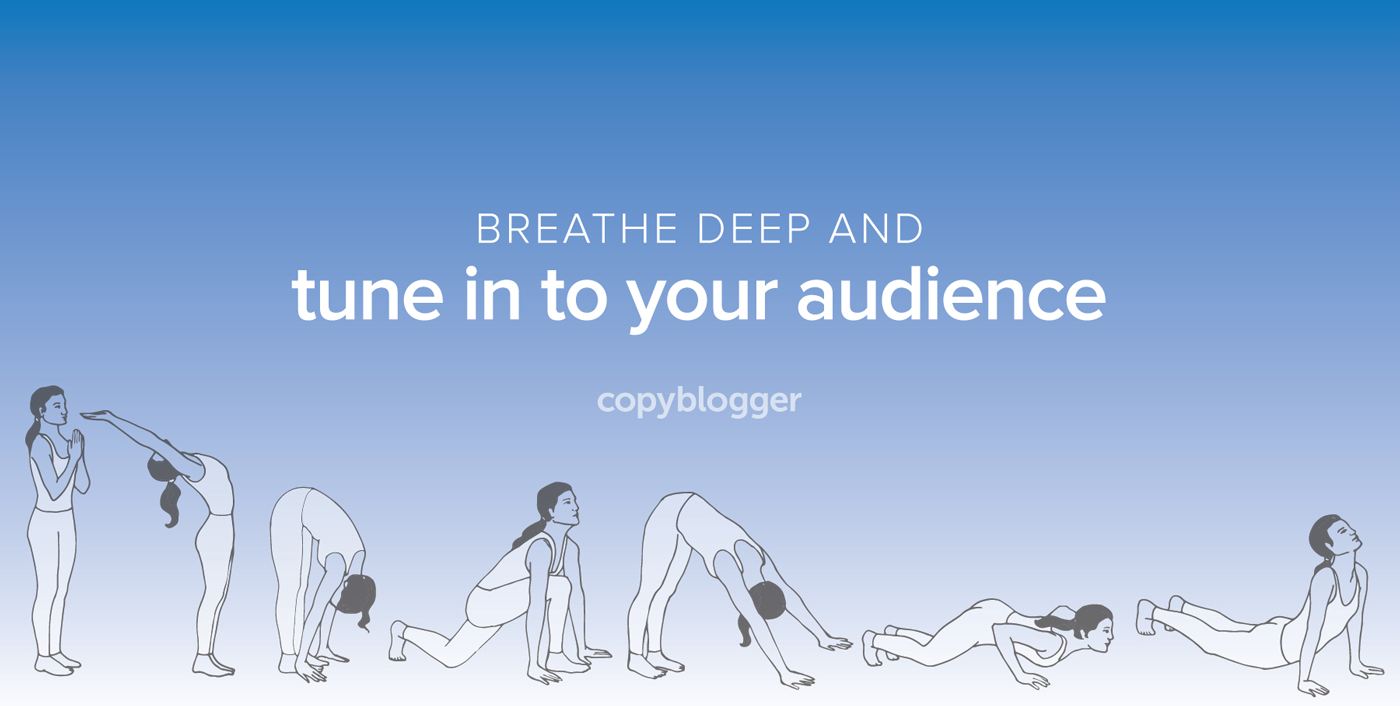Restorative yoga is a gentle, passive practice that promotes relaxation in the body.
The other day at the start of my weekly restorative yoga class, our instructor asked us which areas of the body we’d like to focus on that day.
A few other regular students shouted out, “Shoulders! … Lower back! … Psoas!”
However, I stayed quiet because I started writing this article in my head. Class that day wasn’t going to be restorative for me because I viewed my yoga instructor as a content marketer and her students as her audience members.
While she likely already had a series of poses in mind to teach that day, she asked her audience for feedback that would shape her lesson plan. Tailoring the asanas to her students’ needs would help ensure that they were satisfied and happy that they came to her class.
But did the requests from her students stifle her own vision of what she wanted to teach? Did the suggestions block her own creativity and passion for yoga?
On the contrary, I think her students’ input actually enhanced her creativity and passion for yoga.
The same thing can happen when you find out what your prospects hope to achieve by consuming your content.
Inhale and focus on how you can help
 When you serve an audience, you focus on how your natural abilities, strengths, and knowledge can help people.
When you serve an audience, you focus on how your natural abilities, strengths, and knowledge can help people.
Listening to your audience’s problems gives you direction. You don’t aimlessly create content. You recognize what people need help with and then make yourself useful.
An intentionally crafted content marketing strategy familiarizes your ideal customers and clients with your business and the solutions you have to offer them.
Audience input gives you a lens through which to focus all of the wisdom you have to teach.
Once you know what interested prospects need help with, you’re better positioned to spotlight the aspects of your products or services that solve their problems.
Exhale and imagine the right piece of content delivered to the right person at the right time
 My yoga instructor didn’t necessarily abandon her original lesson plan or toss out what she wanted to teach that day.
My yoga instructor didn’t necessarily abandon her original lesson plan or toss out what she wanted to teach that day.
Her students’ requests simply provided a guide for how she could best share her expertise.
She wanted to find out the types of problems her students were having with their bodies that day so she could adapt her class to target their pain points.
As a digital product or service provider, you can use content to demonstrate how you help customers and clients.
Email and marketing automation work together to turn prospects into customers. It’s a powerful combination that allows you to place subscribers on the right lists, trigger the correct broadcast emails or autoresponders, unlock free products, and more.
Your content becomes the friendly, flexible yoga instructor who delivers exactly what her students want, rather than a strict one who follows a pre-established lesson plan.
Envision bringing your best advice to the surface
 Learn about the frustrations and struggles that surround the problems you solve.
Learn about the frustrations and struggles that surround the problems you solve.
Your best advice will rise to the surface, so that you can create effective, custom content and deliver it to the people who will benefit from it the most.
Find out more here.

Reader Comments (26)
Stefanie,
I love your message on how tailoring your article to fit your audience is better than simply writing what you think would work.
I don’t have a huge audience yet so I can’t fully answer your question on how I organise my content to fit my audience. What I found most helpful was to look at the comment section and most popular articles to find out what my audience love the most, and probably what I am best at writing about.
Thanks for sharing!
Cheers,
Anh
Sounds like you’re on the right track, Anh! You can really take advantage of a smaller audience when looking for new content ideas because it’s oftentimes easier to hear individual voices without getting overwhelmed or confused about which direction to go in.
In my niche, people are asking how to make money. In my experience, I found that saving money was even more important. I’m hoping posts on how to make money will draw them in and that they’ll read and consider how to keep more of that money for themselves.
It’s a very workable strategy. When I present programs to job seekers, for example, my presentation is well planned in advance, however, I will ask what’s most pressing and rearrange or emphasize those areas first. When the audience feels connected immediately, and you know that you are delivering, it’s a perfect match.
Hands of to the topic and writing. I can say this is the creative way I have ever seen to represent the idea of content writing and its adoption.
I love to comment on point about imagine and delivery of content to the right person on right time. This is the most important factor when we write the content. Or I can say, we are an artist who writes his/her imagination in a form of a blog post or an article to represent his/her thought to the lovable audiance.
So, I think we should start creating and accepting this the creative ways to write the content.
Corrent me if I am wrong.
Stephanie,
Thank you for the article,
For some time I have been “tailoring”content to fit different Customer Profiles ( Each Profile has unique “Pain Points”).
I take the Raw Draft and then use Headlines and Keywords to fit a specific Customer Profile then repurpose each piece (especially for “top of funnel” material)
I was never sure if this strategy was a good direction to go in.
I am glad to have found that others think the same way…
Thanks for giving me support to continue with this strategy.
Have a great day
Bruce
Stefanie, I had to miss my practice session at the yoga studio today due to my elderly Dad’s illness. Your post content was invaluable and I so loved that you placed it in the framework of pranayama and a few well-chosen asanas. Such amazing creativity! Thanks for helping me to connect to my inner wisdom. XXOO
I’m sorry to hear about your dad’s illness, Ellen. Thanks for taking the time to read the article and share your thoughts!
Hi, Stefani. I have no answer to offer from my own experience. I just felt I had to share how your post affected me. I’ve been studying storytelling techniques for my commercial writing. I’m using yours as an excellent example. Thank you.
Thank you, Missy!
I’m in the process of redoing my website, and asking my audience what they would like to read about is a tool that will make it great. Thank you for confirming that my decision to ask these questions is good to do!
Stefanie, I loved your article. I think it resonated, because I am a Tai Chi instructor. I ask what my Tai Chi students need in class, but not when I post. I do segment my list because it perturbs me when I am on a list and keep getting things that do not pertain to me. Well I know what my post will be about today – “How can I help you.” Oh and Stefanie, that includes you!
Ty, it’s cool to hear how you’ll be applying some of your in-person practices to your online practices. How great that your name is Ty and you teach Tai Chi!
Thanks for such a great example of matching content with your audience’s needs and interests. As mentioned by another reader, noticing the blogs that receive the most attention and comments are a good indicator that this is a topic of value to your audience. I have two different websites offering writing services – one for local government and one for businesses which has helped me to target my content to these different audiences.
I learned a few new tricks, we can always leverage everything we do
Thanks for the great story and lesson Stefanie. I have a custom banner for students that already purchased a course to remind them to make the free course if they didn’t, because it’s foundational to the paid course. I’m starting to tag students to and I can’t wait for the next release of the Rainmaker Platform!
Very cool, Daniel!
I was teaching spoken English at a university in China when Dubya and Gore were facing off. One of my students was getting live election coverage updates from a dormmate via text message. He quickly convinced me that we’d have a much better class if I just scrapped my lesson plan entirely and we discussed the elections in English instead. That was fun, and we used the scrapped lesson plan a week later. All my other speaking classes involved starting with a loose sketchy lesson plan that we stuck to while my students built on it based on their own skills and interests. Thanks for the reminder that content, too, is much better with this sort of collaboration.
That’s a terrific example, Michael! It’s fun to explore how in-person interactions can translate to successful online experiences.
Thanks Stephanie for your post inspired from your yoga instructor. In learning the business side of the business, I am wondering if it is appropriate to ask my readers (growing my reader base) what was it about my last post on The Power of Gratitude that caused the second highest response in 2 years, via verbal, email, blog comments, Facebook, etc., ?
Candy
Great question, Candy! I think it would be appropriate if learning from your readers’ preferences would help you create more content that they’d enjoy. To get the most engaged response, I’d suggest reaching out in way that makes responding easy. One way you could approach it is writing a blog post explaining the reactions you got to The Power of Gratitude and that it’d be helpful for you to find out more about why it resonated with your audience, so you can produce more content like it in the future. Then readers can respond through blog comments.
Really great article, thanks for sharing it Stefanie!
Stefanie,
Really insightful article. You are totally right – our readers come first and we should do our absolute best to create content that they are most likely to respond well too.
Thanks for taking the time to write this up! Cheers
Gabriel
Actually, I really hate it when my yoga teacher asks this question at the start of class. It only ensures the louder, less shy participants get what they want. I never answer and only wish she would simply teach a well rounded class. That said, I understand you message here today. Bear in mind though, that finding out what your audience wants isn’t that simple. Trial and error.
Indeed, there are no shortcuts.
Thanks, Stephanie, for the great metaphor! I am always looking for useful metaphors to illustrate the abstract and often spiritual topics I write about in mental health.
Namaste
This article's comments are closed.